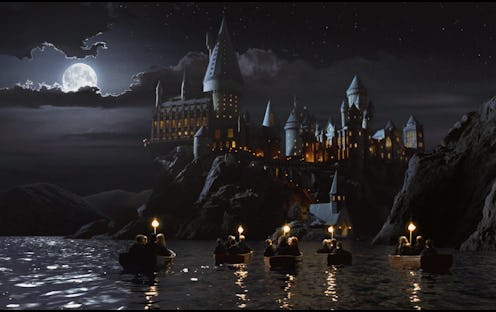
It's been a long nearly nine years since the last Harry Potter book was released, but J.K. Rowling is still busy expanding the amazing fictional world she created. Last June, she confirmed that there’s an American wizarding school, leaving fans to speculate about the other Hogwarts equivalents that may be out there. Finally, at the tail-end of January, the bestselling author revealed the names of four more schools (including the one in the United States), along with profiles of three: Castelobruxo, Mahoutokoro, and Uagadou.
The rival institutions are intriguing, to say the least. Hogwarts may be the fictional place I — and virtually every other Harry Potter fan — would most like to visit (as exemplified by the many popular tourist attractions it has inspired), but these schools, plus Hogwarts' other rivals, have a lot of awe-inspiring characteristics. Although there’s a lot for us to learn about them still, based on what we know at this point, I’d go so far as to say that there are aspects that even our favorite school of witchcraft and wizardry can't top.
Before you assume I’ve been victim to a Confundus Charm, here are eight areas in which Hogwarts sadly doesn’t quite measure up to its rival wizarding schools, no matter how much we love the place:
1. Enchanted Robes
Why every school doesn’t have enchanted robes like Mahoutokoro’s is beyond me. These magical pieces of clothing grow in size with the students, which would have saved the Weasleys so many of their hard-earned galleons. On top of that, they change color the more the wearer learns, going from a faint pink color to gold (as long as the wearer scores top grades in every subject). They even turn white if the wearer practices Dark magic, so Tom Riddle wouldn’t have been able to fool anyone into thinking he was a model student.
2. Massive Grounds
Hogwarts’ grounds are obviously sizable and stunning, but Durmstrang might have it beat. The institute claims a “vast” and “sprawling” expanse, with tons of gorgeous views. Viktor Krum sang the area’s praises at the Yule Ball when he told Hermione all about flying over the institute’s lakes and the mountains.
3. Acceptance Via Dream Messengers
It wouldn’t have been such a struggle for Harry to get his school acceptance letter if he’d been a prospective pupil of Uagadou. The head of the African school notifies students through Dream Messengers, who are dispatched to deliver tokens (usually inscribed stones) by appearing to the kids as they sleep. It’s a little creepy sounding, but it would have saved Hagrid a lot of trouble, not to mention prevented Dudley from the meeting that landed him a pig’s tail.
4. Early Start
Young witches and wizards often start showing signs of magic well before they’re old enough to attend Hogwarts, but they have to wait till they’re 11 years old to start their schooling. Not at Japan’s Mahoutokoro, though: Wizarding children as young as age 7 can enroll as day students. (Instead of a school bus, they catch a ride each day on the backs of giant storm petrels.) Probably thanks to how early the kids start, the school is known for its excellent academics. Presumably the little ones learn how to control their magic at an early age, too, so you have fewer zoo trips ending with an escaped boa constrictor.
5. Quidditch Excellence
Mahoutokoro isn’t just known for its outstanding academics — the school turns out amazing Quidditch players as well. Apparently, training is grueling and they practice over the sea in stormy conditions. Again, the fact that the students start so young might play a hand in the institution’s prowess.
6. Exchange Programs
Sure, Hogwarts is obviously willing to open its doors to students from other schools when the Triwizard Tournament rolls around, but Brazil’s Castelobruxo is showing Harry’s alma mater up when it comes to exchange programs. Located in the rainforest, it welcomes students from all over Europe to study Herbology.
7. Magical Fountain
With its silk robes and gorgeous carriage, Beauxbatons clearly cares about appearance. As further proof, the academy’s park has what is described as a "magnificent" fountain at the center — one believed to have healing and beautifying properties. It would come in handy after a run-in with a Blast-Ended Skrewt, that’s for sure. Fleur Delacour should have mentioned it when she was boasting about her school’s ice sculptures (that do not melt, of course) and choirs of wood nymphs at Christmas.
8. Magical Hand Gestures
Wands are awesome, but they’re not the only way to make magic. Uagadou students use them, but they’re also skilled at using simply a finger or a hand gesture to cast spells. At Hogwarts, on the other hand, not having one of Ollivander’s finest is a major liability. Remember how Ron barely got by when his wand was snapped in a collision with the Whomping Willow? I’m shocked that Hermione never started a campaign to fill this gaping hole in their wizarding education.
Images: Warner Bros.; Giphy (8)